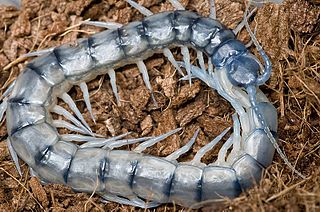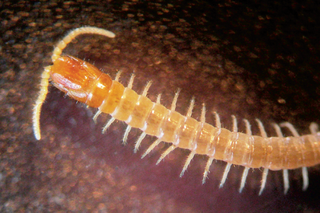
Lithobius is a large genus of centipedes in the family Lithobiidae, commonly called stone centipedes, common centipedes or brown centipedes.

Scolopendra is a species-rich genus of large tropical centipedes of the family Scolopendridae.

Carl August Graf Attems-Petzenstein was an Austrian myriapodologist and invertebrate zoologist. He published 138 scientific papers, most of them dealing with his specialist field, the myriapods. He described about 1800 new species and subspecies from all over the world.

Scutigeridae is a family of centipedes. It includes most of the species known as house centipedes, including Scutigera coleoptrata and Allothereua maculata.

Sphaerotheriida is an order of millipedes in the infraclass Pentazonia, sometimes known as giant pill millipedes. They inhabit Southern Africa, Madagascar, South and Southeast Asia, Australia and New Zealand. Like the Northern Hemisphere pill millipedes of the order Glomerida, these millipedes can roll into a ball when disturbed. When they are rolled-up, most sphaerotheriidans reach a maximum size of a cherry or golf ball, but some species from Madagascar can even reach the size of an orange. When rolled-up, predators are unable to unravel giant pill millipedes since the margins of their second and last dorsal plates fit perfectly into one another, creating a sealed ball. A few giant pill millipede species are able to produce sound, the only millipedes known to do this. This order of millipedes is also unique in that some African species are used for medicinal purposes.
Telodeinopus is a genus of giant African millipedes in family Spirostreptidae, containing eight species:

Zephroniidae is a family of giant pill millipedes in the taxonomic order Sphaerotheriida. They occur in southeast Asia from the Himalayas and China south and east to Sulawesi and to Australia, and also inhabit some Philippine islands.
Pachymerium is a genus of centipedes in the family Geophilidae, containing the following species:

Chordeumatida is a large order of millipedes containing some 1200 species with a nearly worldwide distribution. They possess around 30 body segments and reach about 25 mm (0.98 in) in length.
Siphonophoridae is a family of millipede in the order Siphonophorida. There are about 12 genera and more than 110 described species in Siphonophoridae.
Andrognathidae is a family of millipede in the order Platydesmida. There are about 17 genera and more than 30 described species in Andrognathidae.
Anethoporus is a genus of spirostreptid millipedes native to northern South America, where they range from Peru to the islands of Trinidad and Tobago. The genus and type species, A. clarki, was established by Ralph V. Chamberlin in 1918.

Harpagophoridae is a family of round-backed millipedes of the order Spirostreptida. The family includes 269 species belonging to 55 genera, distributed in Africa, Southeast Asia, and the East Indies, as well as a few Indian Oceanic islands. Two subfamilies are recognized.

Anoplodesmus is a genus of millipedes. It is one of the most species rich genera in the family Paradoxosomatidae, with over 40 described species distributed from India and Nepal to China and Southeast Asia, as well as the Mascarene Islands and Fiji.

Strigamia is a genus of soil centipedes in the family Linotaeniidae. There are at least 50 described species in Strigamia.
Pachydesmus is a genus of flat-backed millipedes in the family Xystodesmidae. There are about 12 described species in Pachydesmus.
Akamptogonus is a genus of flat-backed millipedes in the family Paradoxosomatidae. There are about 11 described species in Akamptogonus.
Rhinotus is a genus of millipedes in the family Siphonotidae. There are at least 20 described species in Rhinotus.

Trigoniulus is a genus of millipede in the family Trigoniulidae. There are at least 90 described species in Trigoniulus.

Tygarrup is a genus of centipedes in the family Mecistocephalidae, native to Europe and Asia. Tygarrup javanicus has become an invasive in greenhouses in Europe.












